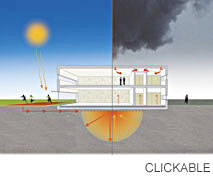ICAX speaks on IHT at the Ground Source Energy Conference
CBI Conference Centre London WC1 26 January
ICAX explains how Interseasonal Heat Transfer can help you address the key issue of combating global warming in a practical way that is in tune with the natural environment.
Protecting and enhancing the environment sits at the heart of sustainability. With the growing awareness that the built environment accounts for nearly half of the UK’s CO2 emissions; innovative, green solutions for designing, constructing and using buildings are in urgent demand.
ICAX answers that demand by providing Interseasonal Heat Transfer which heats buildings in winter without burning fossil fuels by exploiting Ground Source Energy. Surplus solar energy is captured by Asphalt Solar Collectors and stored in ThermalBanks in the summer for release into buildings in winter using a ground source heat pump.
ICAX can help you achieve sustainability in the built environment by storing ground source energy in Thermalbanks.
Edward Thompson is speaking at the Ground Source Energy Conference on:
improving ground source heat pump efficiency for ground source heating and cooling.
The speakers at the Ground Source Energy Conference include:- Brian Kennelly, Ground Source Heat Pump Association
- Karl Drage, Ground Source Heat Pump Association
- Neil Pennell, Head of Sustainability and Engineering, Land Securities
- Joe Schembri, Contracts Manager, Kier London
- David Ritter, Head of Sustainability, BDP
- John Findlay, Director, Carbon Zero Consulting
- Iain Howley, Director, Loopmaster Europe
- Michael Moggeridge, Contracts Manager Magpie Drilling
- Stephen Newman, Technical Director, Asset Investment MITIE Asset Management
- Dr Robin Curtis, Technical Director, Earth Energy Ltd
- James Dickinson, Senior Engineer, Buro Happold
- Edward Thompson, Director, ICAX Ltd
- James Dodds Director, JDIH Envireau
- Mark Mulcahy, Water & Environment Manager, Zenith International
- Paul Hancock, Divisional Technical Director, NG Bailey
Ground Source Energy
Ground source energy is a renewable source of energy which can be used for heating buildings. Architects, consultants and building owners have realised that ground source energy can be exploited the whole year around to provide significant reductions in carbon dioxide emissions and heating and cooling costs.
Heat can extracted from the ground via fluid circulating through an array of pipes in the ground to provide heating to buildings in winter. The ground acts as a "heat source". The ground can also be used as a "heat sink" for heat extracted from a building in summer in order to provide cooling. For the ground to be used as a ThermalBank in this way it is necessary to ensure that there is a balance of heat extracted and heat deposited in the ground over the course of the year.
Thermal Modelling of the complete system is necessary to ensure that this balance is achieved in a sustainable way over the years. If heat is extracted for space heating purposes without any heat being deposited (from cooling the building in summer) there is a risk that the ground temperature will fall each year and the heat pump will cease to be efficient – it may even "lock up". The solution is to collect solar energy in the summer and transfer heat to the ground in advance of the heating season: this is the essence of Interseasonal Heat Transfer and enables the heat pumps in an ICAX Skid to extract heat more cheaply and more efficiently than in an unassisted heat pump installation.
Heat collection for Ground Source Energy
Surplus solar energy can be collected in summer to boost ground source energy in winter by using Asphalt Solar Collectors, Solardec Watertight Collectors or standard solar thermal collectors. The asphalt solar collectors and Solardec can also be used as heat rejectors to disperse heat in systems of Natural Cooling. The most effective combination is found in Interseasonal Heat Transfer which utilises ground source heating and cooling in one integrated system.
Heat distribution from Ground Source Energy
Having extracted heat from the ground using a heat pump, there are various different mechanisms for distributing heat within a building. Because a heat pump is most efficient when delivering warmth – at around 40°C – instead of heat – at around 70°C, it is best to use a distribution system that matches these lower output temperatures. Underfloor heating is ideal, but other options like TermoDeck and VRF fan coil units can also be very effective, as can direct supply to air handling systems.
Earth Energy Systems – EES
A ground source heat pump uses the earth as the source of heat in the winter, and as the "sink" for heat removed from the building in the summer. For this reason, ground source heat pump systems are also known as Earth Energy Systems (EESs).
See Ground Source Heating See Ground Source Cooling Ground Source Energy

